
- Home
- Workshops / Tours
- Diary / Blog
- Galleries
- Foreign Trips
- Tasmania 2016
- NE Queensland 2016
- Western Alps 2016
- NE Spain 2016
- Australia's Wet Tropics 2015
- Australia's Top End 2015
- SW Australia 2015
- Switzerland 2015
- Andalucia 2015
- Belize 2015
- Australia 2014
- Switzerland 2014
- Belize 2014
- Bahama Islands 2014
- Switzerland 2013
- Ecuador 2012-2013
- Florida 2011-2012
- Vancouver Island 2011
- Australia 2010
- Peru 2008
- Bulgaria 2007
- Lesvos 2006
- California 2006
- New Zealand 2005
- Extremadura 2005
- Goa, India 2004
- The Gambia 2003
Ecuador
19th December 2012 - 20th January 2013
Tandayapa
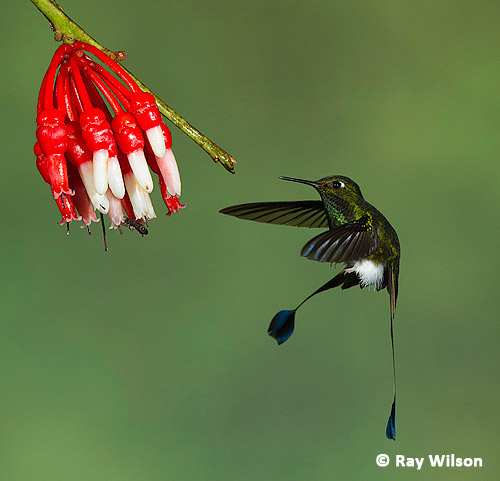
Booted Racket-tail (Ocreatus underwoodii)
visiting Psammisia sp. (Ericaceae) flowers
Our next 3 days were spent in the Tandayapa valley where our focus was again the numerous hummingbirds that visited the feeders.
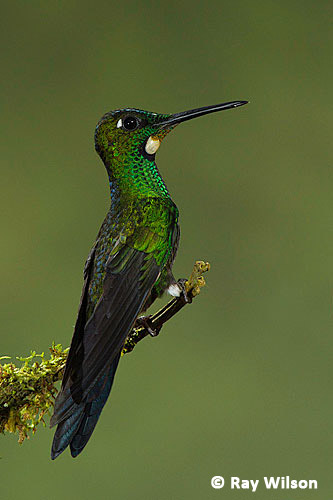
Green-crowned Brilliant (Heliodoxa jacula)(note the tick embedded in its chin) |
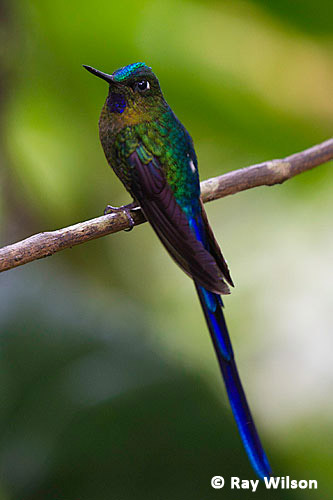
Violet-tailed Sylph (Aglaiocercus coelestis) |
Two of the most spectacular species, Violet-tailed Sylph and Booted Racquet-tail, were also among the commonest.
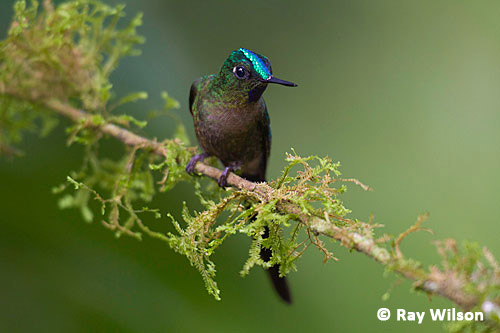
Violet-tailed Sylph (Aglaiocercus coelestis)
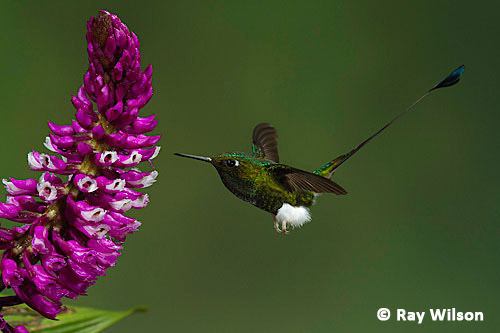
Booted Racket-tail (Ocreatus underwoodii)
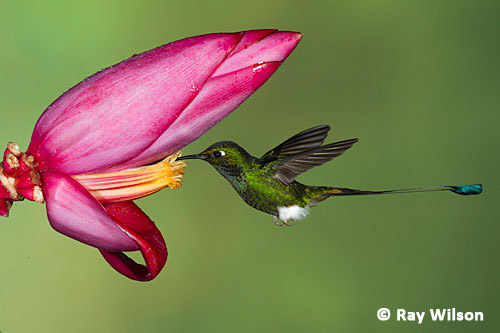
Booted Racket-tail (Ocreatus underwoodii)
The female Booted Racket-tail lacks the long tail "racquets" of the male. The female below seemed to be quite interested in the wasp that flew from the flowers as she approached them to feed on their nectar.
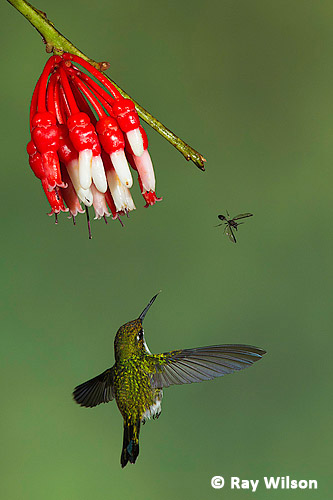
female Booted Racket-tail (Ocreatus underwoodii)
visiting Psammisia sp. (Ericaceae) flowers
Another very common species we encountered was the Buff-tailed Coronet.

Buff-tailed Coronet (Boissonneaua flavescens) |
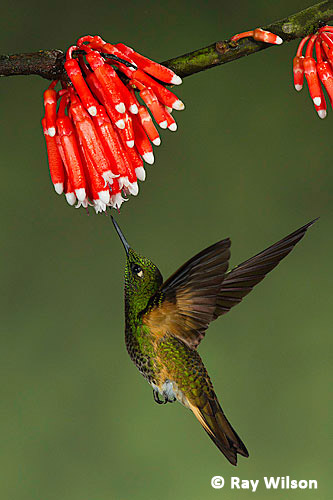
Buff-tailed Coronet (Boissonneaua flavescens) |
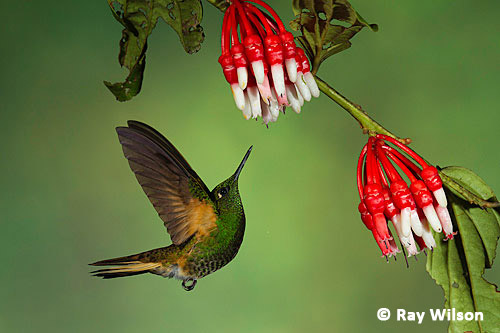
Buff-tailed Coronet (Boissonneaua flavescens)
visiting Psammisia sp. (Ericaceae) flowers
The species shown below helped to make up the supporting cast with the Purple-bibbed White-tip being the least regularly seen.
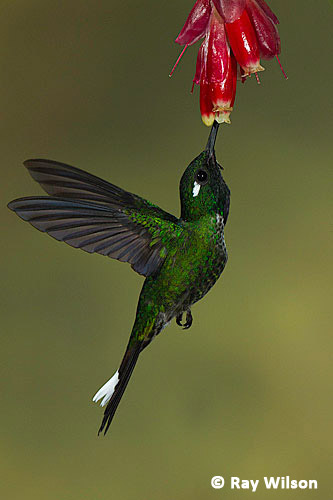
Purple-bibbed Whitetip (Urosticte benjamini) |
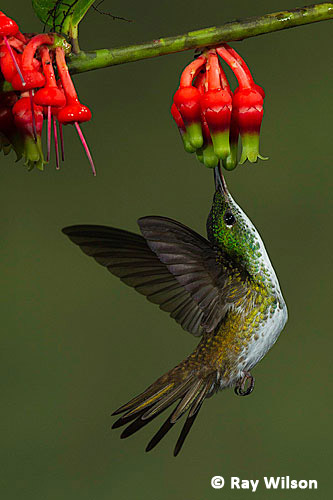
Andean Emerald (Amazilia franciae) |
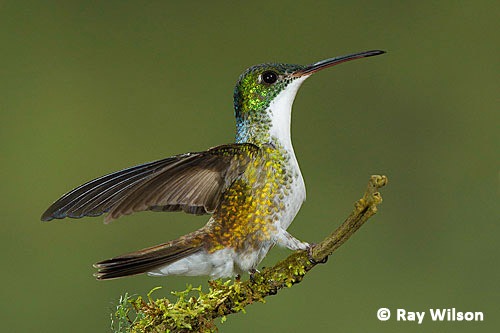
Andean Emerald (Amazilia franciae)
Some of the smaller hummingbirds, such as the woodstars, beat their wings an incredible 80 time per second when hovering and their flight action is very reminiscent of a large bee.
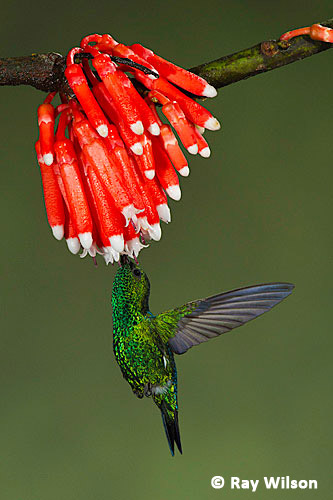
Western Emerald (Chlorostilbon melanorhynchus) |
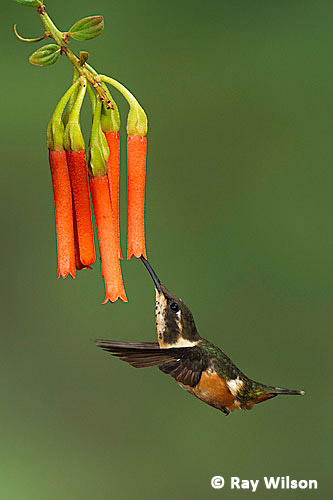
Purple-throated Woodstar (Calliphlox mitchellii) |
At the back of the lodge, I found a Red-faced Spinetail that was busily constructing its nest.
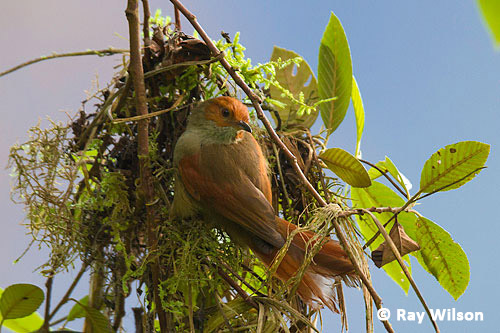
Red-faced Spinetail (Cranioleuca erythrops) building a nest
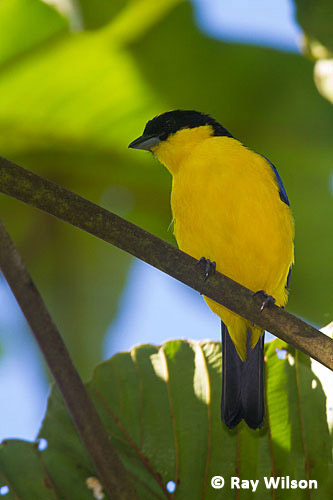
Blue-winged Mountain-Tanager (Anisognathus somptuosus)
We didn't have much luck with seeing many roving tanager flocks, and only one small group of Blue-winged Mountain-Tanagers came close enough for us to get some decent photos.
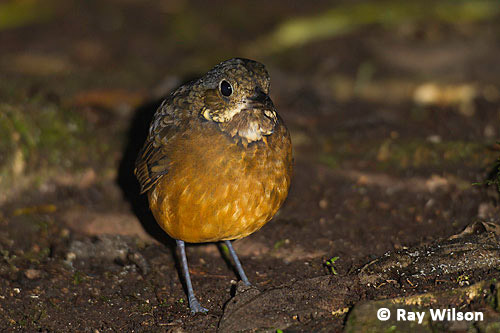
Scaled Antpitta (Grallaria guatimalensis)
About 500m along one of the trails from the lodge is a feeding station for Scaled Antpitta which requires a very early visit if you want to see it. Unfortunately, it is almost pitch black on the forest floor at that time in the morning and, as well as having to rely on flash as the main light source, focusing on the bird was a major problem. It's very difficult to get anything in sharp focus when all you can see in the viewfinder is a vague shadow moving around!
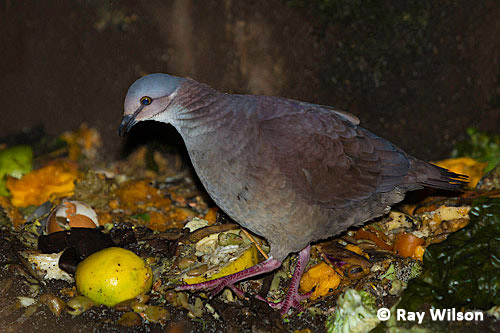
White-throated Quail-dove (Geotrygon frenata)
White-throated Quail-doves are attracted to the kitchen scraps and Strong-billed Woodcreeper came down to feed on the insects buzzing around the scraps.

Strong-billed Woodcreeper (Xiphocolaptes promeropirhynchus)
The night-lights around the buildings attracted a large variety of moths...
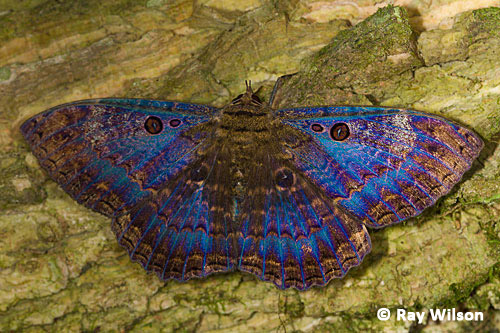
Feigeria pinasi (Noctuidae)
Feigeria pinasi was one of the largest moths I found around the lodge. It was also fairly common with at least 5 individuals being present every night.
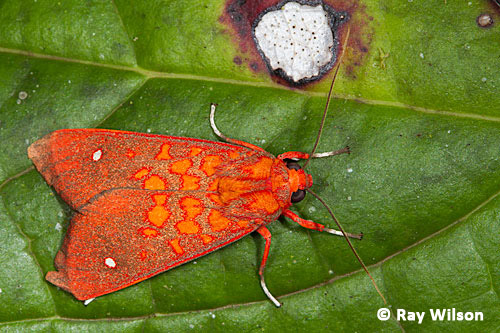
Melese sp. (Arctiidae)
There are several very similar species in the genus Melese found in the Tandayapa valley.
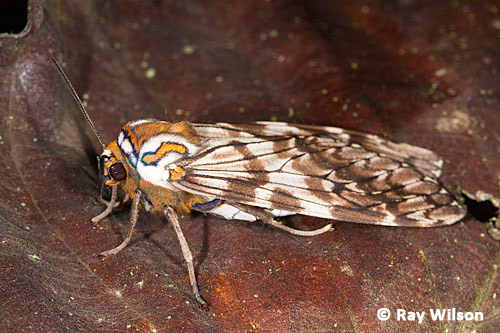
Hemihyalea watkinsii (Arctiidae)

Chafer sp. (Scarabaeidae)
Rufous-collared Sparrow is probably one of the commonest and most widespread birds in South America. The individual below was particularly cooperative and sat posing for us for over 10 minutes.

Rufous-collared Sparrow (Zonotrichia capensis)
A day-trip to Milpe Bird Sanctuary produced a few lower altitude species not found further up the valley. Of these, the gorgeous Velvet-purple Coronet was one of my favourite birds of the whole trip.
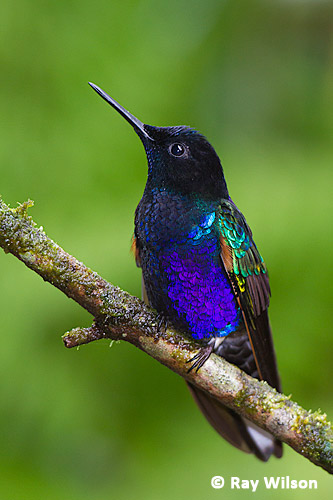
Velvet-purple Coronet (Boissonneaua jardini)
The weather was pretty awful during our time at Milpe, with only brief periods when it wasn't raining as heavily as it was in the photo below...
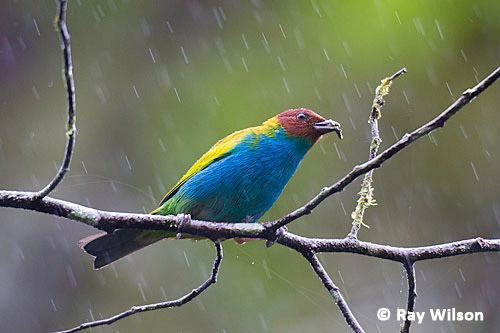
Bay-headed Tanager (Tangara gyrola)
Ornate Flycatchers were common along the trails.
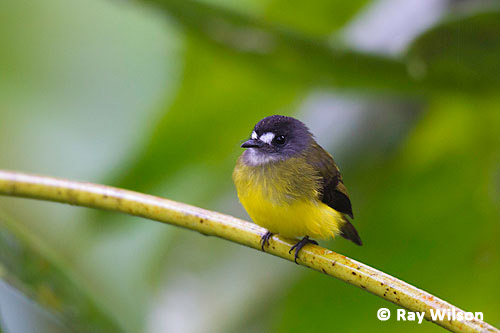
Ornate Flycatcher (Myiotriccus ornatus)
The Club-winged Manakin lek was not very active due to the heavy rain but a couple of birds finally started displaying during one of the brief breaks in the rain...
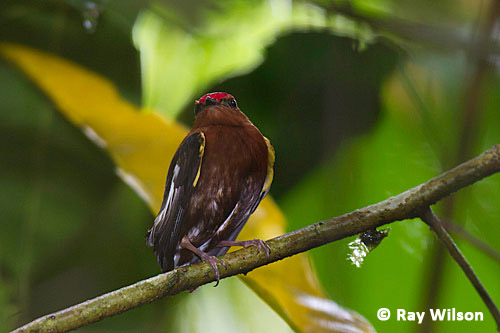
Club-winged Manakin (Machaeropterus deliciosus) performing a "crouch-call" display
The Club-winged Manakin has quite a complex display with 6 different display behaviours having been scientifically described. These are: the "wing-flash"; the "backward wing-flash"; the "crouch-call"; the "wing-presentation"; the "jump-turn" and the "lateral spring".
The two display behaviours illustrated in the photos above and below are the "crouch-call", which is fairly self-explanatory, and the "jump-turn", which involves the bird jumping vertically, executing a 180°-turn and landing up to 15cm away from its launch point, facing the opposite direction.

Club-winged Manakin (Machaeropterus deliciosus) performing a "jump-turn" display
On our final morning, as we were preparing to leave the lodge, the staff alerted us to the presence of a sloth that had come to the ground and was slowly climbing back up a tree at the back of the lodge.
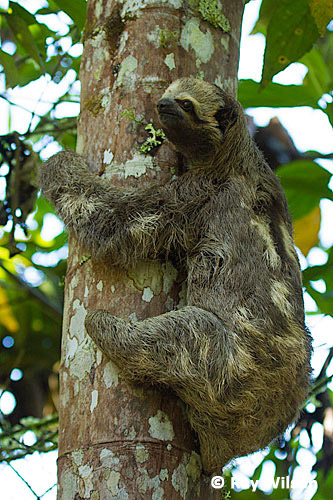
Brown-throated Sloth (Bradypus variegatus)
| Yanacocha | Quito |
Ray Wilson owns the copyright of all images on this site.
They may not be used or copied in any form without prior written permission.
raywilsonphotography@googlemail.com